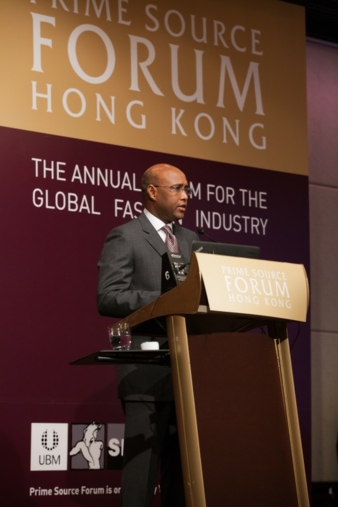23/06/2015 — auf Deutsch lesen
10th anniversary: Africa
Prime Source Forum Hong Kong, the annual forum for the global fashion industry, focused on the latest issues facing the fashion apparel industry. The event was established in 2006 by APLF Ltd and joint venture partner UBM Asia Ltd. After eight successful events, Yeh Shen Ltd started running it under licence from APLF.
The keynote speech was delivered by Hon. Adan Mohamed, Cabinet Secretary, Ministry of Industrialisation and Enterprise Development, Kenya who focused on sourcing opportunities in Africa. “Africa is rising,” he opened, citing Kenya’s advantages as a production and sourcing base. Not only does it have its own cotton production and plenty of affordable industrial land, but it also boasts low utility rates, plenty of low-cost labour, and a central location in East.
Africa is predicted to be the second fastest growing region up to 2020 with the largest supply of available labour in the world by 2035. Moreover, COMESA (Common Market of East and Southern Africa) with 19 member countries, the EAC (East Africa Community) with 5 member states and SADC (South African Development Community) will converge into one free trading region and consumer market by 2025. In conclusion Adan Mohamed said, “Asia is today while Africa is tomorrow.”
The six conference sessions covered the most important issues currently facing the industry:
With new retail patterns driven by the millennials, the speakers explored what future sourcing will look like. Online fast fashion with multi brands is increasingly popular among millennials. Speakers pointed out that this group prefers small experimental brands that are growing fast through the internet. They want seamless multi-channel distribution and are concerned about the environment and sustainability.
China remains the main apparel sourcing location though some production has shifted to S.E. Asia, even Africa. Near-shoring will become more important. This creates an opportunity for supply chain management and integrated supply chain technology.
In the past the market was driven by manufacturers but now the retailers and consumers are in the driving seat. As manufacturing costs go up, buyers are still expecting prices to go down. So how can these two perspectives meet? It appears that partnering, ie taking retail to manufacturing, is the answer.
It was pointed out that production accounts for just 5% of total costs, while selling and marketing absorb 65% or more. The focus should, therefore, be on reducing the cost of selling instead of production. Waste reduction is another angle as is technology.
If you want to go fast, go alone; if you want to go far, go together, stated Tom Nelson, VP Supply Chain of VF Corp. Sustainability and chemical safety are becoming more important. Key brands from the US and EU are coming together under GAFTI’s 2020 Vision to solve problems and set standards.
Speakers believe Africa is the next apparel sourcing hub for the world, especially if China and India invest in production there. Textile and apparel is high on the governments’ agenda. The dynamics are ripe for change, the stars are aligned, the speakers believe. Africa wants to attract vertical set ups from fibre to yarn, fabrics to finished products. They pointed out that Africa is a huge market with many countries, each developing at a different pace. You cannot talk about Africa as one country. Governments look at textiles and apparel as the key to helping Africa out of poverty. East Africa does not currently have enough infrastructure and factories but they believe they can be built quickly to bring it up to the same level as Asia today.
Whilst multinational brands and retailers embark on programmes like ‘zero discharge of hazardous chemicals by 2010’, the Chinese Government unveiled new environmental measures in 2015 that all textile companies are required to observe. What impact will this have on apparel sourcing? China is really serious about the environment with the passing of the environmental law in January 2015. It will pose a big challenge for the dyeing and finishing industry.
We need to train companies to improve at less cost, said Hans Buehr, Executive Director of the Hong Kong Intimate Apparel Industries Association. Costs will go up, but there is still a lot of room for environmental improvement. The question is, are consumers willing to pay more? Many think not. Costs can, however, be lowered in other areas.
Sangem Hsu, president of Centre Testing International Corp, said the cost of non-compliance would be much higher than compliance. On April 1, 2015 the law on Solid Waste Pollution came into effect as a criminal law punishable by imprisonment. Sangem Hsu believes sustainability is possible through waste reduction, energy and operational efficiency, data monitoring, ethical business models and continuous improvement. It was suggested that there should be an industry standard and not country by country.
To improve the Bangladeshi employer-worker-relationship and safety conditions, western experience is being teamed up with responsible sourcing knowledge. The Rani Plaza disaster was indeed a wake-up call for worker safety. During the conference, this was quite a heated topic where the Bangladesh Garment Manufacturers and Exporters Association gave an update on the Government’s and the industry’s efforts to implement change in the past couple of years. It was suggested that the responsibility for improvements should be shouldered by the Government and the BGMEA rather than the brands which can only lend support.
[Vicky Sung, Hong Kong]





